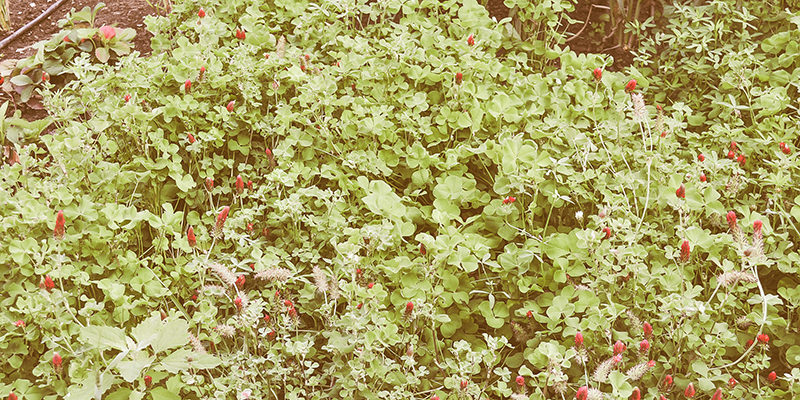Farmers and vintners alike would argue magic doesn’t exist in the vineyards that quench our thirst each year, but I’d argue clover — four-leafed or not — comes close, and has been doing so for millennia.
Trifolium, commonly known as clover, is a “nitrogen-fixing” plant, meaning it returns nitrogen from the air back to soils, a vital process that increases farmland fertility. As such, it makes clover a beloved cover crop in vineyards from Mendocino to Piedmont and everywhere in between. Clover, and other nutrient powerhouses like barley and oats, have the power to transform poor, exhausted soils into rich, complex growing mediums, and it’s completely awe-inspiring.
A cover crop is simply a non-cash crop — like clover, peas, or oats — planted in addition to a cash crop, like grapes or corn, in fallow fields or between vine rows. Mostly grasses and cereal grains, these crops often look like boring green carpeting, but are really Mother Nature’s secret weapon for restoring soil vitality and increasing biodiversity. And unlike the chemical fertilizers that dominate in America’s farmlands, cover crops are organic and don’t contribute to toxic streams of runoff.
Though the process of planting a second set of crops might sound expensive, daunting, and a little bit crazy, the practice is taking hold across the country, and for good reason. As The New York Times recently highlighted, cover cropping increases yields and soil quality, all while creating a potential second cash crop for farmers. In terms of vineyards, cover crops also offer protection from erosion, and a small safety net of moisture during droughts like the one currently plaguing California. All of that means less dependence on harsh chemical companies and more money for organic farmers.
After years of conventional farming, soils lose the nutrients that made them fertile, because grapevines and other plants absorb nutrients like carbon, nitrogen, and potassium to bear grapes and other produce. Cover crops, which thrive on a different set of nutrients than most cash crops, replenish these nutrients during the off-season. Carefully selected and pruned as meticulously as the vines, these plants are often mistaken as “landscaping,” but are critical to the health and sustainability of vineyards.
The magic begins after the late summer harvest, when vintners plant their first round of cover crops between the barren vines. The exact cover crop cocktail varies by region and vineyard site depending on natural nutrient deficiencies or surpluses. Barley, for example, adds carbon to stripped soils, while peas contribute nitrogen and encourage beneficial insects — in addition to producing gorgeous purple blooms.
As the seeds germinate and then mature, their roots break through hard depleted soils, incorporating oxygen into the ground while securing topsoil. Most cover crops have vast but shallow root systems, which keep dirt tightly in place through severe winter rainstorms. These same root systems also hold excess water in place, allowing fields to remain productive during drought years.
Once the plants mature, farmers mow the crops, further integrating their genetic matter into the soil. Pea shoots, grains, and wilted lupin flowers then become a compost layer as the conventional growing season starts anew.
Quite marvelously, native grasses and thistles often creep into cover-cropped vineyards as soils thrive after a few seasons of the practice, along with birds, bees, and tons of earth worms. If that’s not farmland magic, what is?

